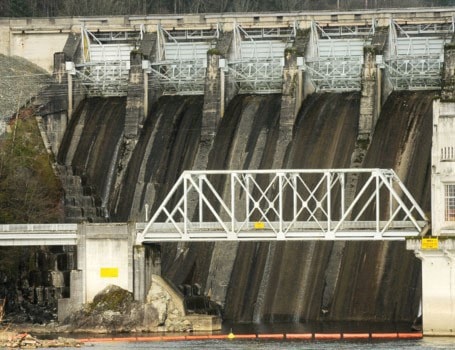B.C. Hydro’s recently announced rebuild of Ruskin Dam will boost generating capacity, make it safer in an earthquake and cost $800 million.
So why not add a fish ladder in the process and allow salmon to get into the reservoir beyond and eventually Stave Lake, where they could multiply and rebuild stocks?
In the late 1990s, B.C. Hydro said it would, providing it could be proven that the Stave actually had sockeye, says Barry Radelet.
That proof came when a colleague found a sockeye skeleton when the lake level was lowered, he says. So will B.C.Hydro now honour its commitment and put in the ladder, Radelet is asking.
The prospect, though, has been raised before – and dismissed – after debate and research.
Geoff Clayton, with the Alouette River Management Society, said connecting the Lower Stave River at the Maple Ridge-Mission border to the Ruskin reservoir, then to the Stave reservoir was checked over carefully in the late 1990s.
The question was researched as part of the water-use plan being developed for the area by Fisheries and Oceans Canada, B.C. Hydro, Kwantlen First Nation, the provincial government, as well as conservation groups.
Clayton said consultant Dr. John Stockner even took core samples of the bottom of Stave Lake to see if traces of carbon and nitrogen from Pacific salmon were present. If they were, it would have indicated the presence of sockeye before the dam was built. However, none was found.
The research also concluded that Stave Falls, about eight metres high, formed a natural obstacle that fish couldn’t pass in order to get into the reservoir.
“So there’s no way that we can conceive of fish getting up there,” Clayton said.
A fish ladder for the Ruskin Dam downstream of the Stave Falls Dam was also considered, but the size of the Hayward Lake Reservoir and lack of streams feeding it didn’t make it strong candidate.
Instead, efforts were focused on building side channels and spawning habitat for the Lower Stave River, basically from the Lougheed Highway to the base of Ruskin Dam.
“It has proved very, very valuable,” Clayton said.
That small section of river now hosts a run of 250,000 chum salmon, which would-be anglers snag from the shoreline every fall.
Sports fishermen also take steelhead, cutthroat and coho salmon as they make their way up the river.
While it may seem like a short stretch of river, the Lower Stave has three times the aquatic habitat of the South Alouette River and seven times the water volume, Clayton pointed out.
“It’s one of the great successes,” along with the South Alouette water use plan. Both plans ensure a stable flow of water from the river as Hydro manages its power and reservoir levels.
Clayton said it still makes more sense to put a fish ladder around the Alouette Dam, only about 11 metres high, so the recently re-established sockeye run can get direct access to Alouette Lake and its spawning habitat.
The Alouette River Management Society currently traps the returning sockeye at its hatchery then drives them around the dam before dumping them in the lake to continue their spawning cycle.
Previous to letting juvenile sockeye escape the reservoir a few years go, to continue their life cycle in the Pacific Ocean, the sockeye in Alouette Lake were considered kokanee salmon that become lake bound with the building of the dam in 1926.
